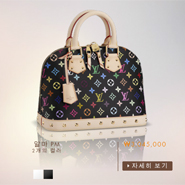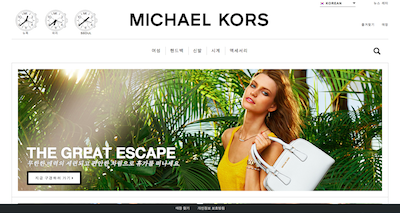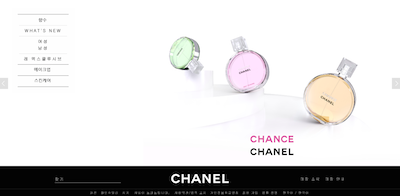 Louis Vuitton's Korean site
Louis Vuitton's Korean site
South Korea poses an opportunity for retail ecommerce due to its tech-savvy, brand aware citizens, according to a new report by Borderfree.
Borderfree gave South Korea four out of five carts in its Index, giving it a “desirable market” status. With consumers in the country willing to spend cross-border to avoid import price hikes, there is an opening for U.S. brands and retailers in this Asian market.
"From an ecommerce perspective, South Korea is an attractive market for luxury online retailers, given the country’s strong currency, demonstrated zeal for shopping online, access to credit cards and high-speed internet connections," said Michael DeSimone, CEO of Borderfree, New York. "South Koreans have a penchant for luxury brands and are recognized across Asia for their high level of sophistication.
"South Korean pop culture and TV shows have a significant and often direct influence on consumers’ purchases, making product placements an extremely powerful marketing tool," he said. "For example, a YSL lipstick worn in the television series 'My Love From the Stars' sold out internationally, and many other luxury products prominently featured in the show also sold well.
"It is also worth noting that South Korean department stores are increasing their share of foreign brands and luxury items and the government has been introducing polices to reduce the price of luxury imported goods."
Borderfree’s report includes its Index, based on a composite score for five criteria: consumer appetite for buying outside of the country, household income and purchasing power, relative currency strength, ease of import and expected market growth.
Connected to culture
South Koreans are heavily influenced by pop culture, with both online and traditional media. They have a penchant for luxury goods, and an awareness of brands in the United States, since many have lived in or visited the U.S.
 Michael Kors Korean Web site
South Korea is ranked ninth in number of travelers to the U.S., with 1.2 million tourists to the country in 2012. Over the past decade, there have been 650,000 students from South Korea that studied abroad in the U.S.
The top 10 most popular labels include Marc by Marc Jacobs and Prada.
Eighty percent of the population in South Korea is online, due to fast, inexpensive Internet service. The country boasts the fastest Internet speed in the world.
More than three quarters of South Koreans own a smartphone, leading to mobile shopping. For 18- to 24-year-olds, this amount climbs to 98 percent.
Michael Kors Korean Web site
South Korea is ranked ninth in number of travelers to the U.S., with 1.2 million tourists to the country in 2012. Over the past decade, there have been 650,000 students from South Korea that studied abroad in the U.S.
The top 10 most popular labels include Marc by Marc Jacobs and Prada.
Eighty percent of the population in South Korea is online, due to fast, inexpensive Internet service. The country boasts the fastest Internet speed in the world.
More than three quarters of South Koreans own a smartphone, leading to mobile shopping. For 18- to 24-year-olds, this amount climbs to 98 percent.
 Photo from Samsung Korea
Many have turned to online shopping as a way to get around the higher prices charged for imports at local stores.
Spending habits
South Korea was ranked the fourth largest economy in Asia, behind China, Japan and India.
Photo from Samsung Korea
Many have turned to online shopping as a way to get around the higher prices charged for imports at local stores.
Spending habits
South Korea was ranked the fourth largest economy in Asia, behind China, Japan and India.
 Chanel Korean ecommerce site
Consumers may not have as much disposable income as those in neighboring countries, but they are more likely to own and use credit cards.
South Koreans have on average five credit cards, compared to two in the U.S., and the country has the highest credit card penetration globally. Consumers in South Korea also use credit more often. There are 129.7 credit card transactions per year in South Korea, compared to 77.9 credit card transactions annually in the U.S.
Retail ecommerce sales are rising, with $25.3 billion projected spend for 2017.
"While South Koreans spend less on average than other parts of Asia – in 2013 South Koreans who shopped with Borderfree retailers spent an average of $158 per order compared to $234 in Singapore and $321 in Hong Kong – the country remains a top country for retailers, as its relatively larger population means that wealth is less concentrated," Mr. DeSimone said.
"There are other distinguishing factors that make South Korea particularly well-suited for cross-border ecommerce, brand awareness and consumer engagement with luxury brands including its high-speed internet, high credit card penetration and global mindset," he said. "South Korea is the third top country in terms of number of foreign students to the U.S. in 2013, following China and India."
Rising star
With multiple top-tier brand businesses, lucrative new consumer groups and a rapidly-growing affluent spend rate, South Korea is poised to be the next luxury powerhouse in Asia, even overtaking Japan, according to a 2012 study by Luxe Brand Advisors.
Since not many luxury brands understand the market – or, more specifically, the power that it has – not many of them have been using South Korea to their advantage, according to the report. However, bricks-and-mortar locations complemented by a strong ecommerce strategy can help marketers get hold of this market (see story).
South Korea ranks behind Hong Kong, but ahead of Japan in English proficiency. However, language can still be a barrier to cross-border purchases, since consumers want to shop in their native language.
Therefore, brands have been working to make it easier for consumers in South Korea to access information.
Chanel Korean ecommerce site
Consumers may not have as much disposable income as those in neighboring countries, but they are more likely to own and use credit cards.
South Koreans have on average five credit cards, compared to two in the U.S., and the country has the highest credit card penetration globally. Consumers in South Korea also use credit more often. There are 129.7 credit card transactions per year in South Korea, compared to 77.9 credit card transactions annually in the U.S.
Retail ecommerce sales are rising, with $25.3 billion projected spend for 2017.
"While South Koreans spend less on average than other parts of Asia – in 2013 South Koreans who shopped with Borderfree retailers spent an average of $158 per order compared to $234 in Singapore and $321 in Hong Kong – the country remains a top country for retailers, as its relatively larger population means that wealth is less concentrated," Mr. DeSimone said.
"There are other distinguishing factors that make South Korea particularly well-suited for cross-border ecommerce, brand awareness and consumer engagement with luxury brands including its high-speed internet, high credit card penetration and global mindset," he said. "South Korea is the third top country in terms of number of foreign students to the U.S. in 2013, following China and India."
Rising star
With multiple top-tier brand businesses, lucrative new consumer groups and a rapidly-growing affluent spend rate, South Korea is poised to be the next luxury powerhouse in Asia, even overtaking Japan, according to a 2012 study by Luxe Brand Advisors.
Since not many luxury brands understand the market – or, more specifically, the power that it has – not many of them have been using South Korea to their advantage, according to the report. However, bricks-and-mortar locations complemented by a strong ecommerce strategy can help marketers get hold of this market (see story).
South Korea ranks behind Hong Kong, but ahead of Japan in English proficiency. However, language can still be a barrier to cross-border purchases, since consumers want to shop in their native language.
Therefore, brands have been working to make it easier for consumers in South Korea to access information.
 Approximately 60 percent of luxury brands offer a Web site for Korean consumers, compared to 96 percent for consumers in China and 87 percent for consumers in Japan, according to L2 Think Tank’s series of Digital IQ Index Reports.
The Digital IQ Index: Korea and the Digital IQ Index: The Gateways, which comprises Hong Kong, Taiwan and Singapore, found that although the Asia-Pacific area is one of the world’s wealthiest regions, luxury marketers are not making themselves accessible to these consumers via digital media. Although many luxury brands are invested in China, marketers need to have a presence in other nearby areas to reach their full global potential (see story).
Brands looking to enter South Korea can look to the successful strategies of others.
"While there is pent-up demand in Asia for American luxury brands, the most successful online retailers are employing localized marketing tactics and promotions to make the most of the opportunity," Mr. DeSimone said.
"One of the most basic, but also most important strategies, is translating part or all of the Web site into Korean, as Koreans are most comfortable shopping in their own language," he said. "Similarly, offering quick delivery times and customer service in-language can go a long way.
"Another strategy worth considering is engaging with local online communities like Malltail and Naver, which can help spread news about a certain product coming into stock or goes on sale. Some of our retailers have seen a major boost in sales when product news has gone viral.
"The most successful retailers also develop a targeted mobile marketing and commerce strategy based on market insights. For example, around 60 percent of Borderfree’s Korea sales and 20 percent of the country’s population are based in Seoul, which translates into significant benefits for geo-targeted ads."
Final Take
Sarah Jones, editorial assistant on Luxury Daily, New York
Approximately 60 percent of luxury brands offer a Web site for Korean consumers, compared to 96 percent for consumers in China and 87 percent for consumers in Japan, according to L2 Think Tank’s series of Digital IQ Index Reports.
The Digital IQ Index: Korea and the Digital IQ Index: The Gateways, which comprises Hong Kong, Taiwan and Singapore, found that although the Asia-Pacific area is one of the world’s wealthiest regions, luxury marketers are not making themselves accessible to these consumers via digital media. Although many luxury brands are invested in China, marketers need to have a presence in other nearby areas to reach their full global potential (see story).
Brands looking to enter South Korea can look to the successful strategies of others.
"While there is pent-up demand in Asia for American luxury brands, the most successful online retailers are employing localized marketing tactics and promotions to make the most of the opportunity," Mr. DeSimone said.
"One of the most basic, but also most important strategies, is translating part or all of the Web site into Korean, as Koreans are most comfortable shopping in their own language," he said. "Similarly, offering quick delivery times and customer service in-language can go a long way.
"Another strategy worth considering is engaging with local online communities like Malltail and Naver, which can help spread news about a certain product coming into stock or goes on sale. Some of our retailers have seen a major boost in sales when product news has gone viral.
"The most successful retailers also develop a targeted mobile marketing and commerce strategy based on market insights. For example, around 60 percent of Borderfree’s Korea sales and 20 percent of the country’s population are based in Seoul, which translates into significant benefits for geo-targeted ads."
Final Take
Sarah Jones, editorial assistant on Luxury Daily, New York
